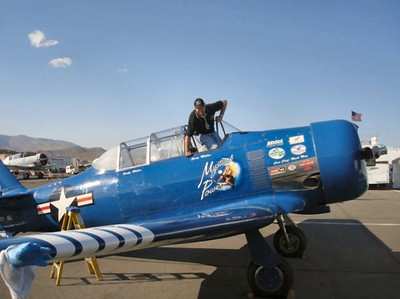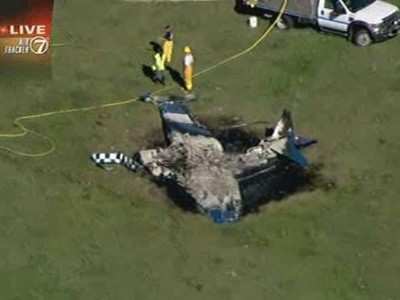Sun, Jul 19, 2009
Accomplished Warbird Pilot Lost In Aerobatic Practice
 The NTSB has filed the
first concrete details in the investigation into the fatal accident
that claimed SNJ pilot and airshow flyer, Gary Miller. Miller was
an ATP who had been flying since 14 years of age and was taught to
fly by his Dad. He had over 800 hours in the SNJ/T-6 and some 2500
hours total time. Most recently, he made a living in aviation sales
and as a corporate pilot. He was Reno race qualified and had raced
for several years. He also was an ICAS member with a low-level
aerobatic waiver.
The NTSB has filed the
first concrete details in the investigation into the fatal accident
that claimed SNJ pilot and airshow flyer, Gary Miller. Miller was
an ATP who had been flying since 14 years of age and was taught to
fly by his Dad. He had over 800 hours in the SNJ/T-6 and some 2500
hours total time. Most recently, he made a living in aviation sales
and as a corporate pilot. He was Reno race qualified and had raced
for several years. He also was an ICAS member with a low-level
aerobatic waiver.
NTSB Identification: CEN09FA425
14 CFR Part 91: General Aviation
Accident occurred Thursday, July 09, 2009 in Simila, CO
Aircraft: NORTH AMERICAN SNJ-5, registration: N212TC
Injuries: 1 Fatal.
This is preliminary information, subject to change, and may
contain errors. Any errors in this report will be corrected when
the final report has been completed.
On July 9, 2009, about 1255 mountain daylight time, a North
American SNJ-5 model airplane, N212TC, was destroyed following
impact with terrain near Simla, Colorado. The airline transport
pilot was fatally injured. The flight was being conducted under the
provisions of Title 14 Code of Federal Regulations Part 91. Visual
meteorological conditions prevailed at the time of the
accident.
Four witnesses observed the airplane performing aerobatic
maneuvers for approximately 15 minutes. They could not estimate how
high the airplane was flying, but indicated it was too high to make
out details on the airplane. They observed the airplane pull up
vertical and perform a wing over or roll type maneuver. The
airplane then entered a spin, which continued until the airplane
impacted the ground. A post impact fire erupted immediately after
impact.

Examination of the airplane showed the fuselage from the leading
edge of the horizontal stabilizer forward to the engine firewall
mostly consumed by fire. The inboard half of the left wing and the
inboard four feet of the right wing were mostly consumed by
fire.

All flight control surfaces were present in the wreckage and
flight control cable continuity was verified from all flight
control surfaces to the forward cockpit.
More News
Aero Linx: JAARS Nearly 1.5 billion people, using more than 5,500 languages, do not have a full Bible in their first language. Many of these people live in the most remote parts of>[...]
'Airplane Bounced Twice On The Grass Runway, Resulting In The Nose Wheel Separating From The Airplane...' Analysis: The pilot reported, “upon touchdown, the plane jumped back>[...]
"Burt is best known to the public for his historic designs of SpaceShipOne, Voyager, and GlobalFlyer, but for EAA members and aviation aficionados, his unique concepts began more t>[...]
"Polaris Dawn, the first of the program’s three human spaceflight missions, is targeted to launch to orbit no earlier than summer 2024. During the five-day mission, the crew >[...]
There Are SO Many Ways To Get YOUR Aero-News! It’s been a while since we have reminded everyone about all the ways we offer your daily dose of aviation news on-the-go...so he>[...]
 ANN's Daily Aero-Linx (05.04.24)
ANN's Daily Aero-Linx (05.04.24) NTSB Final Report: Quest Aircraft Co Inc Kodiak 100
NTSB Final Report: Quest Aircraft Co Inc Kodiak 100 Aero-News: Quote of the Day (05.04.24)
Aero-News: Quote of the Day (05.04.24) Aero-News: Quote of the Day (05.05.24)
Aero-News: Quote of the Day (05.05.24) Read/Watch/Listen... ANN Does It All
Read/Watch/Listen... ANN Does It All





